
Allium validum is a species of flowering plant commonly called swamp onion, wild onion, Pacific onion, or Pacific mountain onion. It is native to the Cascade Range, to the Sierra Nevada, the Rocky Mountains, and other high-elevation regions in California, Oregon, Washington, Nevada, Idaho and British Columbia. It is a perennial herb and grows in swampy meadows at medium and high elevations.

Madia is a genus of annual or perennial usually aromatic herbs with yellow flowers, in the tribe Madieae within the family Asteraceae.
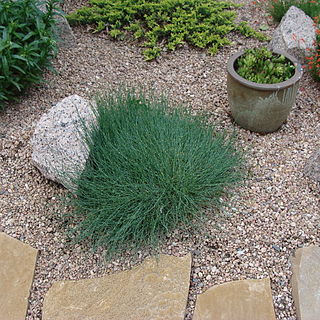
Ephedra funerea is a species of Ephedra, known by the common name Death Valley jointfir, Death Valley ephedra, or Mormon Tea.

Baccharis sergiloides is a species of Baccharis known by the common name desert baccharis.
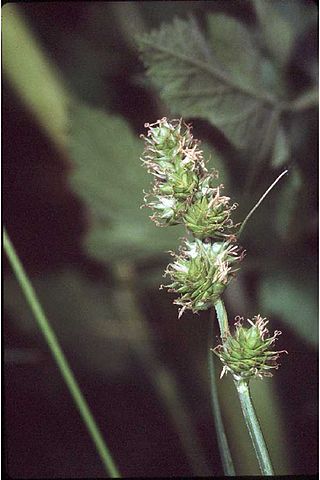
Carex molesta is a species of sedge known by the common name troublesome sedge. It is native to eastern and central North America, where it grows in varied wet and dry habitats, performs equally well in full sun and partial shade, including disturbed areas such as roadsides. It is an introduced species and often a weed in California.

Cirsium andersonii is a North American species of thistle known by the common names Anderson's thistle and rose thistle. It is native to California, Oregon, and Nevada, where it grows in the woodlands and forest openings of the local high mountain ranges, including the Sierra Nevada and the southern Cascade Range. It has also been reported from Idaho.
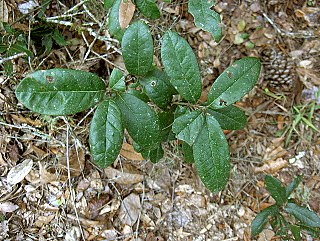
Quercus minima, the dwarf live oak or minimal oak, is a North American species of shrubs in the beech family. It is native to the southeastern United States. It is placed in the southern live oaks section of the genus Quercus.

Holocarpha virgata is a species of flowering plant in the family Asteraceae known by the common names yellowflower tarweed, pitgland tarweed, and narrow tarplant.

Dieteria canescens is an annual plant or short lived perennial plant in the family Asteraceae, known by the common names hoary tansyaster and hoary-aster.
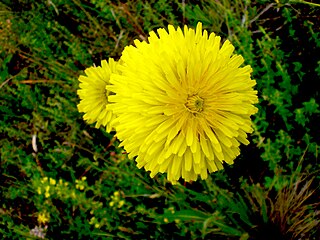
Microseris laciniata is a species of flowering plant in the family Asteraceae known by the common name cutleaf silverpuffs. It is native to the western United States from Washington to northern California and Nevada, where it grows in forest and grassland habitat.
Sedella congdonii is a species of flowering plant in the family Crassulaceae known by the common name Congdon's mock stonecrop. It is endemic to California, where it can be found in the Sierra Nevada, often in rocky and moist habitat types. It is an annual herb growing just a few centimeters high. The oval succulent leaves are just a few millimeters long. The flowers occur in a cyme on thin branches. Each has yellow petals no more than 3 millimeters long.

Phacelia hastata is a species of flowering plant in the borage family, Boraginaceae. Its common names include silverleaf scorpionweed, silverleaf phacelia, and white-leaf phacelia. It is native to western North America from British Columbia and Alberta south to California and east to Nebraska. It can be found in many types of habitat, including scrub, woodland, and forest, up to an elevation of 13,000 feet. It prefers sandy to rocky soil.

Pilostyles thurberi is a species of endoparasitic flowering plant known by the common names Thurber's stemsucker and Thurber's pilostyles. It is native to the southwestern United States and northern Mexico, where it grows in desert and woodland. In the United States, P. thurberi has been recorded from the states of Arizona, California, New Mexico, Nevada, Texas.
Stuckenia striata is a species of aquatic plant known by the common names broadleaf pondweedNevada pondweed and striped pondweed. It is native to the Americas, including the southwestern United States, northern Mexico, and parts of Central and South America. It grows in waterways such as rivers, canals, and shallow ponds, often in alkaline water. This is a perennial herb producing a long, thin, branching stem approaching 2 m in maximum length. The narrow, hairlike leaves are up to 10 cm (3.9 in) long and only a few millimeters wide. The inflorescence is a spike of flowers arranged in whorls and borne on a short peduncle.

Rorippa subumbellata is a rare species of flowering plant in the family Brassicaceae known by the common names Lake Tahoe yellowcress and Tahoe yellow cress. It is known only from the shores of Lake Tahoe, straddling the border between California and Nevada. There are an estimated fourteen populations of the plant still in existence. It grows only on the direct shoreline of the lake, occupying a seven-foot semi-aquatic zone between the high- and low-tide marks. It is directly impacted by recreational activities on the lake, enduring bombardment by boat wakes, trampling, and construction of docks and other structures.
Trichophorum clementis is a species of flowering plant in the sedge family known by the common name Yosemite bulrush. It is endemic to the Sierra Nevada of California, where it is known from high-elevation mountain meadows and streambanks.

Solidago spectabilis is a species of goldenrod known by the common names Nevada goldenrod, basin goldenrod, and showy goldenrod. It is native to the western United States in the Great Basin and surrounding areas. It is found in California, Arizona, Nevada, Oregon, and Utah. There are historical records saying it once grew in southwestern Idaho, but is now extirpated there. This variety has also been seen in the western Montana county of Sanders.
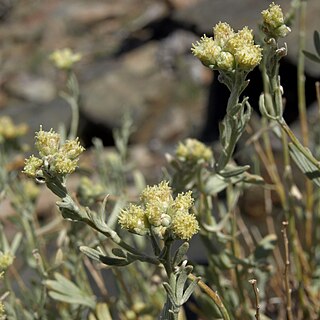
Sphaeromeria cana is a species of flowering plant in the family Asteraceae known by the common name gray chickensage. It is native to the western United States, where it is known from the Sierra Nevada, the adjacent desert ranges of eastern California and Nevada, and Steens Mountain of Oregon. It grows in dry, rocky mountain habitat, such as cracks and crevices, including the talus above the tree line. This is an aromatic subshrub with numerous erect branches growing up to 30 to 60 centimeters tall. It is gray-green in color and coated with woolly fibers. The leaves are linear or lance-shaped, the lower ones divided into lobes. The inflorescence is generally a cluster of flower heads lined with woolly phyllaries and containing yellow disc florets. There are no ray florets. The fruit is a ribbed achene about 2 millimeters long.

Pelecyphora minima is a rare species of cactus known by the common names Nellie cory cactus, Nellie's pincushion cactus, birdfoot cactus, and others. It is a very popular species among cactus collectors. This is one reason why it is a highly endangered species in the wild today. This cactus is found only in Brewster County, Texas, in the United States, where there are three populations remaining near Marathon. The cactus is limited to one outcrop in the Marathon Uplift, where it grows in rocky novaculite soils. It was added to the endangered species list in 1979.

Paronychia chartacea is a rare species of flowering plant in the family Caryophyllaceae known by the common names papery Whitlow-wort and paper nailwort. It is endemic to Florida in the United States. There are two subspecies of the plant; ssp. chartacea occurs in Central Florida, especially the Lake Wales Ridge, and ssp. minima is native to the Florida Panhandle. The two subspecies are geographically separated and do not occur together. Both are included on the federal Endangered Species List, on which the species is designated threatened.

















